Are Spanish TTOs Prepared to Innovation in a COVID Context?
Abstract
1. Introduction
2. Theoretical Background
2.1. Ambidexterity of Technology Transfer Offices
2.1.1. Ambidextrous Orientation of the Technology Transfer Offices
2.1.2. Individual Ambidexterity in the Technology Transfer Offices
2.2. Relational Capital of the Technology Transfer Offices
3. Methodology
Population, Sample and Measures
4. Results
5. Discussion and Conclusions
Author Contributions
Funding
Institutional Review Board Statement
Informed Consent Statement
Data Availability Statement
Conflicts of Interest
Appendix A
| Ambidextrous Orientation | |
|---|---|
| Exploratory Orientation | Exploitative Orientation |
| (a) looks for novel technological ideas by thinking “outside the box” for companies and/or academic | (a) commits to improve quality and lower cost |
| (b) bases its success on its ability to explore new technologies | (b) continuously improves the reliability of its products and services |
| (c) creates products or services that are innovative to the TTO | (c) constantly surveys existing customers’ satisfaction |
| (d) looks for creative ways to satisfy its customers’ needs (companies and/or academics) | (d) improves what it offers to keep its current customers satisfied |
| (e) aggressively ventures into new national market segments | (e) carries out activities that encourage the use of services aimed at current customers |
| (f) actively targets new national customer groups | (f) increases the levels of automation in its operations |
| Individual Ambidexterity | |
|---|---|
| Individual Exploratory Orientation | Individual Exploitative Orientation |
| (a) search for new academics to be involved in the performance of the TTO | (a) perform activities where a lot of experience had been accumulated by them |
| (b) search for new markets, companies, sectors with which to sign agreements | (b) perform activities which serve existing customers with existing services/products |
| (c) perform activities requiring some adaptability on his/her part | (c) perform activities where it is clear to him/her how to conduct them |
| (d) perform activities requiring him/her to acquire new skills or knowledge | (d) perform activities primarily focused on achieving short-term goals |
References
- Blankesteijn, M.; Bossink, B.; Van der Sijde, P. Science-based entrepreneurship education as a means for university-industry technology transfer. Int. Entrep. Manag. J. 2021, 17, 779–808. [Google Scholar] [CrossRef]
- Vega-Gómez, F.; Miranda-González, F. Choosing between Formal and Informal Technology Transfer Channels: Determining Factors among Spanish Academicians. Sustainability 2021, 13, 2476. [Google Scholar] [CrossRef]
- Libecap, G. University Entrepreneurship and Technology Transfer: Process, Design, and Intellectual Property; Elsevier: Amsterdam, The Netherlands, 2005. [Google Scholar]
- Algieri, B.; Aquino, A.; Succurro, M. Technology transfer offices and academic spin-off creation: The case of Italy. J. Technol. Transf. 2013, 38, 382–400. [Google Scholar] [CrossRef]
- Secundo, G.; De Beer, C.; Passiante, G. Measuring university technology transfer efficiency: A maturity level approach. Meas. Bus. Excell. 2016, 20, 42–54. [Google Scholar] [CrossRef]
- Curi, C.; Daraio, C.; Llerena, P. University technology transfer: How (in)efficient are French universities. Camb. J. Econ. 2012, 36, 629–654. [Google Scholar] [CrossRef]
- Deiaco, E.; Holmén, M.; McKelvey, M. What does it mean conceptually thatuniversities compete? In Learning to Compete in European Universities: From Social Institution to Knowledge Business; McKelvey, M., Holmén, M., Eds.; Edward Elgar: Cheltenham, UK, 2009; pp. 300–328. [Google Scholar]
- Etzkowitz, H.; Webster, A.; Gebbardt, C.; Cantisano Terra, B. The future of the University of the future: Evolution of ivory tower to entrepreneurial paradigm. Res. Policy 2000, 29, 313–330. [Google Scholar] [CrossRef]
- Martin, B. The changing social contract for science and the evolution of the university. In Science and innovation: Rethinking the Rationales for Funding and Governance; Edward Elgar: Cheltenham, UK, 2003; pp. 7–29. [Google Scholar]
- Miyata, Y. An empirical analysis of innovative activity of universities in the United States. Technovation 2000, 20, 413–425. [Google Scholar] [CrossRef]
- Mustar, P.; Wright, M. Convergence or path dependency in policies to foster the creation ofuniversity spin-off firms? A comparison of France and the United Kingdom. J. Technol. Transf. 2010, 35, 42–65. [Google Scholar] [CrossRef]
- Mustar, P.; Wright, M.; Clarysse, B. University spin-off firms: Lessons from ten years of experience in Europe. Sci. Public Policy 2008, 35, 67–80. [Google Scholar] [CrossRef]
- Sofía-Olaya, E.; Berbegal-Mirabent, J.; Germán-Duarte, O.G. Performance of university transfer offices as intermediaries for the potentiation of the knowledge market. Intang. Cap. 2014, 10, 155–188. [Google Scholar]
- Debackere, K. The TTOs, an organizational innovation to facilitate technology transfer. In University Technology Transfer and Academic Entrepreneurship; World Scientific: Toh Tuck Link, Singapore, 2018; pp. 23–41. [Google Scholar] [CrossRef]
- O’Shea, R.; Allen, T.; O’Gorman, C.; Rocher, F. Universities and technology transfer: A review of academic entrepreneurship literature. Ir. J. Manag. 2004, 25, 11–29. [Google Scholar]
- Siegel, D.; Waldman, D.; Link, A. Assessing the impact of organizational practices on the relative productivity of university technology transfer offices: An exploratory study. Res. Policy 2003, 32, 27–48. [Google Scholar] [CrossRef]
- Caldera, A.; Debande, O. Performance of Spanish universities in technology transfer: An empirical analysis. Res. Policy 2010, 39, 1160–1173. [Google Scholar] [CrossRef]
- Friedman, J.; Silberman, J. University technology transfer: Do incentives, management, and location matter. J. Technol. Transf. 2003, 28, 17–30. [Google Scholar] [CrossRef]
- Petruzzelli, A.M.; Rotolo, D.; Albino, V. Determinants of patent citations in biotechnology: An analysis of patent influence across the industrial and organizational boundaries. Technol. Forecast. Soc. Chang. 2015, 91, 208–221. [Google Scholar] [CrossRef]
- Soto-Acosta, P.; Popa, S.; Palacios-Marques, D. Social web knowledge sharing and innovation performance in knowledge-intensive manufacturing SMEs. J. Technol. Transf. 2017, 42, 425–440. [Google Scholar] [CrossRef]
- Lafuente, E.; Berbegal-Mirabent, J. Assessing the productivity of technology transfer offices: An analysis of the relevance of aspiration performance and portfolio complexity. J. Technol. Transf. 2019, 44, 778–801. [Google Scholar] [CrossRef]
- Mascarenhas, C.; Marques, C.S.; Galvão, A.R.; Carlucci, D.; Falcão, P.F.; Ferreira, F.A. Analyzing technology transfer offices’ influence for entrepreneurial universities in Portugal. Manag. Decis. 2019, 57, 3473–3491. [Google Scholar] [CrossRef]
- Holgersson, M.; Aaboen, L. A literature review of intellectual property management in technology transfer offices: From appropriation to utilization. Technol. Soc. 2019, 59, 101132. [Google Scholar] [CrossRef]
- Bessant, J.; Rush, H. Building bridges for innovation: The role of consultants in technology transfer. Res. Policy 1995, 24, 97–114. [Google Scholar] [CrossRef]
- Siegel, D.S.; Veugelers, R.; Wright, M. Technology transfer offices and commercialization of university intellectual property: Performance and policy implications. Oxf. Rev. Econ. Policy 2007, 23, 640–660. [Google Scholar] [CrossRef]
- Fernández-Alles, M.; Ramos, A. The International Potential of Academic Spin-Offs in Spain; UCA: Farnham, UK, 2021. [Google Scholar]
- Rasmussen, E.; Wright, M. How can universities facilitate academic spin-offs? An entrepreneurial competency perspective. J. Technol. Transf. 2015, 40, 782–799. [Google Scholar] [CrossRef]
- Sinell, A.; Iffländer, V.; Muschner, A. Uncovering transfer-a cross-national comparative analysis. Eur. J. Innov. Manag. 2018, 21, 70–95. [Google Scholar] [CrossRef]
- Gorączkowska, J. Enterprise innovation in technology incubators and university business incubators in the context of Polish industry. Oeconomia Copernic. 2020, 11, 799–817. [Google Scholar] [CrossRef]
- Clarysse, B.; Tartari, V.; Salter, A. The impact of entrepreneurial capacity, experience and organizational support on academic entrepreneurship. Res. Policy 2011, 40, 1084–1093. [Google Scholar] [CrossRef]
- Hülsbeck, M.; Lehmann, E.E.; Starnecker, A. Performance of technology transfer offices in Germany. J. Technol. Transf. 2013, 38, 199–215. [Google Scholar] [CrossRef]
- O’Shea, R.P.; Allen, T.J.; Chevalier, A.; Roche, F. Entrepreneurial orientation, technology transfer and spin-off performance of U.S. Universities. Res. Policy 2005, 34, 994–1009. [Google Scholar] [CrossRef]
- Powers, J.; McDougall, P. University start-up formation and technology licensing with firms that go publics: A resource-based view of academic entrepreneurship. J. Bus. Ventur. 2005, 20, 291–311. [Google Scholar] [CrossRef]
- Ustundag, A.; Ugurlu, S.; Serdar, M. Evaluating the performance of technology transfer offices. J. Enterp. Inf. 2011, 24, 322–337. [Google Scholar] [CrossRef]
- Muscio, A. What drives the university use of technology transfer offices? Evidence from Italy. J. Technol. Transf. 2010, 35, 181–202. [Google Scholar] [CrossRef]
- Huyghe, A.; Knockaert, M. The influence of organizational culture and climate on entrepreneurial intentions among research scientists. J. Technol. Transf. 2015, 40, 138–160. [Google Scholar] [CrossRef]
- Ambos, T.C.; Makela, K.; Birkinshaw, J.; D’Este, P. When does university research get commercialized? Creating ambidexterity in research institutions. J. Manag. Stud. 2008, 45, 1424–1447. [Google Scholar] [CrossRef]
- Chang, Y.C.; Yang, P.Y.; Chen, M.H. The determinants of academic research commercial performance: Towards an organizational ambidexterity perspective. Res. Policy 2009, 38, 936–946. [Google Scholar] [CrossRef]
- Chang, Y.C.; Yang, P.Y.; Martin, B.R.; Chi, H.R. Entrepreneurial universities and research ambidexterity: A multilevel analysis. Technovation 2016, 54, 7–21. [Google Scholar] [CrossRef]
- Tushman, M.; Smith, W.K.; Wood, R.C.; Westerman, G.; O’Reilly, C. Organizational designs and innovation streams. Ind. Corp. Chang. 2010, 19, 1331–1366. [Google Scholar] [CrossRef]
- O’Reilly, C.A.; Tushman, M.L. Ambidexterity as a dynamic capability: Resolving the innovator’s dilemma. Res. Organ. Behav. 2008, 28, 185–206. [Google Scholar] [CrossRef]
- Raisch, S.; Birkinshaw, J. Organizational ambidexterity: Antecedents, outcomes, and moderators. J. Manag. 2008, 34, 375–409. [Google Scholar] [CrossRef]
- Benner, M.J.; Tushman, M.L. Exploitation, exploration, and process management: The productivity dilemma revisited. Acad. Manag. Rev. 2003, 28, 238–256. [Google Scholar] [CrossRef]
- Siggelkow, N.; Levinthal, D.A. Temporarily divide to conquer: Centralized, decentralized, and reintegrated organizational approaches to exploration and adaptation. Organ. Sci. 2003, 14, 650–669. [Google Scholar] [CrossRef]
- Raisch, S.; Birkinshaw, J.; Probst, G.; Tushman, M.L. Organizational ambidexterity: Balancing exploitation and exploration for sustained performance. Organ. Sci. 2009, 20, 685–695. [Google Scholar] [CrossRef]
- Lubatkin, M.H.; Simsek, Z.; Ling, Y.; Veiga, J.F. Ambidexterity and performance in small-to medium-Sized firms: The pivotal role of top management team behavioral integration. J. Manag. 2006, 32, 646–672. [Google Scholar] [CrossRef]
- Carey, S.; Lawson, B.; Krause, D.R. Social capital configuration, legal bonds and performance in buyer-supplier relationships. J. Oper. Manag. 2011, 29, 277–288. [Google Scholar] [CrossRef]
- Tsai, W.; Ghoshal, S. Social capital and value creation: The role of intrafirm networks. Acad. Manag. J. 1998, 41, 464–476. [Google Scholar]
- Yayla, S.; Yeniyurt, S.; Uslay, C.; Cavusgil, E. The role of market orientation, relational capital, and internationalization speed in foreign market exit and re-entry decisions under turbulent conditions. Int. Bus. Rev. 2018, 27, 1105–1115. [Google Scholar] [CrossRef]
- Fernández-Alles, M.; Diánez-González, J.P.; Rodríguez-González, T.; Villanueva-Flores, M. TTOs characteristics and university entrepreneurship: A cluster analysis. J. Sci. Technol. Policy Manag. 2019, 10, 61–889. [Google Scholar] [CrossRef]
- Jensen, R.A.; Thursby, M.C. Patent licensing and the research university (No. w10758). Natl. Bur. Econ. Res. 2004. [Google Scholar] [CrossRef]
- Siegel, D.S.; Phan, P. Analyzing the effectiveness of university technology transfer: Implications for entrepreneurship education. In Advances in the Study of Entrepreneurship, Innovation, and Economic Growth; Emerald Group Publishing Limited: Bingley, UK, 2005; Volume 16, pp. 1–38. [Google Scholar]
- Kenney, M.; Patton, D. Reconsidering the Bayh-Dole Act and the current university invention ownership model. Res. Policy 2009, 38, 1407–1422. [Google Scholar] [CrossRef]
- Lockett, A.; Siegel, D.; Wright, M.; Ensley, M.D. The creation of spin-off firms at public research institutions: Managerial and policy implications. Res. Policy 2005, 34, 981–993. [Google Scholar] [CrossRef]
- Krueger, N.F.; Cummings, B.; Nichols, S.P. From Bureaucratic Tech Transfer to Entrepreneurial Tech Commercialization. Available online: https://papers.ssrn.com/sol3/papers.cfm?abstract_id=1288942 (accessed on 3 June 2021).
- Markman, G.; Phan, P.; Balkin, D.; Gianiodis, P. Entrepreneurship and university-based technology transfer. J. Bus. Ventur. 2005, 20, 241–263. [Google Scholar] [CrossRef]
- Padilla-Meléndez, A.; Garrido-Moreno, A. Open innovation in universities: What motivates researchers to engage in knowledge transfer exchanges? Int. J. Entrep. Behav. Res. 2012, 18, 417–439. [Google Scholar] [CrossRef]
- Secundo, G.; De Beer, C.; Fai, F.M.; Schutte, C.S. Increasing university entrepreneurialism: Qualitative insights from the technology transfer office. Meas. Bus. Excell. 2019, 23, 253–268. [Google Scholar] [CrossRef]
- De la Puente, F.; Martínez, C.; Equiza, S.; Mata, F.J. OTRI: Entre la Relación y el Mercado; Newbook Ediciones: Pamplona, Spain, 2000. [Google Scholar]
- Lambert, R. Lambert Review of Business-university Collaboration: Final Report. Available online: https://globalhighered.files.wordpress.com/2009/09/lambert_review_2003.pdf (accessed on 3 June 2021).
- Clarysse, B.; Wright, M.; Lockett, A.; Van de Velde, E.; Vohora, A. Spinning out new ventures: A typology of incubation strategies from European research institutions. J. Bus. Ventur. 2005, 20, 183–216. [Google Scholar] [CrossRef]
- Lockett, A.; Siegel, D.; Wright, M.; Franklin, S. Technology transfer and universities’ spin-out strategies. Small Bus. Econ. 2003, 20, 185–200. [Google Scholar] [CrossRef]
- Lockett, A.; Wright, M. Resources, capabilities, risk capital and the creation of university spin-out companies. Res. Policy 2005, 34, 1043–1057. [Google Scholar] [CrossRef]
- McAdam, M.; McAdam, R. High tech start-ups in University Science Park incubatiors: The relationship between the start-up’s lifecycle profession and use of the incubator’s resources. Technovation 2008, 28, 277–290. [Google Scholar] [CrossRef]
- Mosey, S.; Wright, M. From human capital to social capital: A longitudinal study of technology based academic entrepreneurs. Entrep. Theory Pract. 2007, 31, 909–935. [Google Scholar] [CrossRef]
- Rodeiro, D.; Fernández, S.; Otero, L.; Rodríguez, A. Determining factors in the creation of university spin-offs. Eur. J. Manag. Bus. Econ. 2010, 19, 47–68. [Google Scholar]
- Siegel, D.; Waldman, D.; Atwater, L.; Link, A. Toward a model of the effective transfer of scientific knowledge from academician stopractitioners: Qualitative evidence from the commercialization of university technologies. J. Eng. Technol. Manag. 2004, 21, 115–142. [Google Scholar] [CrossRef]
- Vohora, A.; Wright, M.; Lockett, A. Critical junctures in the development of university high-tech spinout companies. Res. Policy 2004, 33, 147–175. [Google Scholar] [CrossRef]
- O’Reilly, C.A.; Tushman, M.L. The ambidextrous organisation. Harv. Bus. Rev. 2004, 82, 74–84. [Google Scholar]
- Tushman, M.L.; O’Reilly, C.A. Ambidextrous organisations-managing evolutionary and revolutionary change. Calif. Manag. Rev. 1996, 38, 8–30. [Google Scholar] [CrossRef]
- Floyd, S.W.; Lane, P.J. Strategizing throughout the organization: Managing role conflict in strategic renewal. Acad. Manag. Rev. 2000, 25, 154–177. [Google Scholar] [CrossRef]
- Adler, P.; Goldoftas, B.; Levine, D. Flexibility versus efficiency? A case study of model changeovers in the Toyota production system. Organ. Sci. 1999, 10, 43–68. [Google Scholar] [CrossRef]
- Burgers, J.H.; Jansen, J.J.P.; Van den Bosch, F.A.J.; Volberda, H.W. Structural differentiation and corporate venturing: The moderating role of formal and informal integration mechanisms. J. Bus. Ventur. 2009, 24, 206–220. [Google Scholar] [CrossRef]
- Eisenhardt, K.M.; Tabrizi, B.N. Accelerating adaptive processes: Product innovation in the global computer industry. Adm. Sci. Q. 1995, 40, 84–110. [Google Scholar] [CrossRef]
- Katila, R.; Ahuja, G. Something old, something new: A longitudinal study of search behavior and new product introduction. Acad. Manag. J. 2002, 45, 1183–1194. [Google Scholar]
- McGrath, R. Exploratory learning, innovative capacity, and managerial oversight. Acad. Manag. J. 2001, 44, 118–131. [Google Scholar]
- Phene, A.; Tallman, S.; Almeida, P. When do acquisitions facilitate technological exploration and exploitation? J. Manag. 2012, 38, 753–783. [Google Scholar] [CrossRef]
- Rothaermel, F.T.; Deeds, D.L. Exploration and exploitation alliances in biotechnology: A system of new product development. Strateg. Manag. J. 2004, 25, 201–221. [Google Scholar] [CrossRef]
- Sarkees, M.; Hulland, J. Innovation and efficiency: It is possible to have it all. Bus. Horiz. 2009, 52, 45–55. [Google Scholar] [CrossRef]
- Yang, H.; Atuahene-Gima, K. Ambidexterity in Product Innovation Management: The Direct and Contingent Effects on Product Development Performance. Available online: https://www.researchgate.net/publication/303321328_Pro-innovation_culture_ambidexterity_and_new_product_development_performance_Polynomial_regression_and_response_surface_analysis (accessed on 3 June 2021).
- O’Reilly, C.A.; Tushman, M.L. Organizational ambidexterity: Past, present, and future. Acad. Manag. Perspect. 2013, 27, 324–338. [Google Scholar] [CrossRef]
- Van Looy, B.; Landoni, P.; Callaert, J.; Van Pottelsberghe, B.; Sapsalis, E.; Debackere, K. Entrepreneurial effectiveness of European universities: An empirical assessment of antecedents and trade-offs. Res. Policy 2011, 40, 553–564. [Google Scholar] [CrossRef]
- O’Shea, R.; Hugh, H.; Allen, T. Determinants and consequences of university spinoff activity: A conceptual framework. J. Technol. Transf. 2008, 33, 653–666. [Google Scholar] [CrossRef]
- Stuart, T.E.; Ding, W.W. When do scientists become entrepreneurs? The social structural antecedents of commercial activity in the academic life sciences. Am. J. Sociol. 2006, 112, 97–144. [Google Scholar] [CrossRef] [PubMed]
- Thursby, J.; Kemp, S. Growth and productive efficiency of university intellectual property licensing. Res. Policy 2002, 31, 109–124. [Google Scholar] [CrossRef]
- Bonesso, S.; Gerli, F.; Scapolan, A. The individual side of ambidexterity: Do individuals’ perceptions match actual behaviours in reconciling the exploration and exploitation trade-off? Eur. Manag. J. 2014, 32, 392–405. [Google Scholar] [CrossRef]
- Levinthal, D.A.; March, J.G. The myopia of learning. Strateg. Manag. J. 1993, 14, 95–112. [Google Scholar] [CrossRef]
- Mom, T.J.; Van Den Bosch, F.A.; Volberda, H.W. Understanding variation in managers’ ambidexterity: Investigating direct and interaction effects of formal structural and personal coordination mechanisms. Organ. Sci. 2009, 20, 812–828. [Google Scholar] [CrossRef]
- Xiang, S.; Chen, G.; Liu, W.; Zhou, Q.; Xing, S. An empirical study of the impact of goal orientation on individual ambidexterity-moderating roles of goal interdependence and constructive controversy. Nankai Bus. Rev. Int. 2019, 10, 465–484. [Google Scholar] [CrossRef]
- Gibson, C.B.; Birkinshaw, J. The antecedents, consequences, and mediating role of organizational ambidexterity. Acad. Manag. J. 2004, 47, 209–226. [Google Scholar]
- Hoang, H.; Antoncic, B. Network-based research in entrepreneurship: A critical review. J. Bus. Ventur. 2003, 18, 165–187. [Google Scholar] [CrossRef]
- Lechner, C.; Dowling, M.; Welpe, I. Firm networks and firm development: The role of the relational mix. J. Bus. Ventur. 2006, 21, 514–540. [Google Scholar] [CrossRef]
- Bojica, A.M.; Arroyo, M.R.; Fuentes, M.D.M.F. Knowledge acquisition through interorganizational relationships and entrepreneurial orientation: The mediating role of second-order social capital. Cuad. Econ. Dir. Empresa 2012, 15, 141–153. [Google Scholar]
- Fernández-Alles, M.; Camelo-Ordaz, C.; Franco-Leal, N. Key sources and actors for the evolution of academic spin-offs. J. Technol. Transf. 2015, 40, 976–1002. [Google Scholar] [CrossRef]
- Timmons, J.A.; Spinelli, S. New Venture Creation; McGraw Hill Higher Education: Boston, MA, USA, 2004. [Google Scholar]
- Gübeli, M.H.; Doloreux, D. An empirical study of university spin-off development. Eur. J. Innov. Manag. 2005, 8, 269–282. [Google Scholar] [CrossRef]
- Bjørnåli, E.S.; Gulbrandsen, M. Exploring board formation and evolution of board composition in academic spin-offs. J. Technol. Transf. 2010, 35, 92–112. [Google Scholar] [CrossRef]
- Iglesias-Sánchez, P.P.; Jambrino Maldonado, C.; Peñafiel Velasco, A. Caracterizacion de las spin-off universitarias como mecanismo de transferencia de tecnología a través de un análisis clúster. Rev. Eur. Dir. Econ. Empresa 2013, 21, 240–254. [Google Scholar] [CrossRef][Green Version]
- Kozlowski, S.W.J.; Hattrup, K. A Disagreement About Within-Group Agreement: Disentangling Issues of Consistency Versus Consensus. J. Appl. Psychol. 1992, 77, 161–167. [Google Scholar] [CrossRef]
- James, L.R.; Demaree, R.G.; Wolf, G. rwg: An assessment of within-group interrater agreement. J. Appl. Psychol. 1993, 78, 306–309. [Google Scholar] [CrossRef]
- Everitt, B.S.; Landau, S.; Leese, M.; Stahl, D. Cluster Analysis; Wiley: Chichester, UK, 2011. [Google Scholar]
- Pérez-Lopez, C. Técnicas Estadísticas Multivariantes Con SPSS; Garceta ed: Madrid, Spain, 2009. [Google Scholar]
- Cesaroni, F.; Piccaluga, A. The activities of university knowledge transfer offices: Towards the third mission in Italy. J. Technol. Transf. 2016, 41, 753–777. [Google Scholar] [CrossRef]
- Gorączkowska, J.; Tomaszewski, M. Support of innovation activity in small and medium-sized enterprises in the Greater Poland Voivodeship. Ekon. Prawo. Econ. Law 2019, 18, 183–195. [Google Scholar] [CrossRef]
- Barra, C.; Zotti, R. The contribution of university, private and public sector resources to Italian regional innovation system (in) efficiency. J. Technol. Transf. 2018, 43, 432–457. [Google Scholar] [CrossRef]
- Stankeviciėnė, J.; Kraujalienė, L.; Vaiciukevičiūtė, A. Assessment of technology transfer office performance for value creation in higher education institutions. J. Bus. Econ. Manag. 2017, 18, 1063–1081. [Google Scholar] [CrossRef]
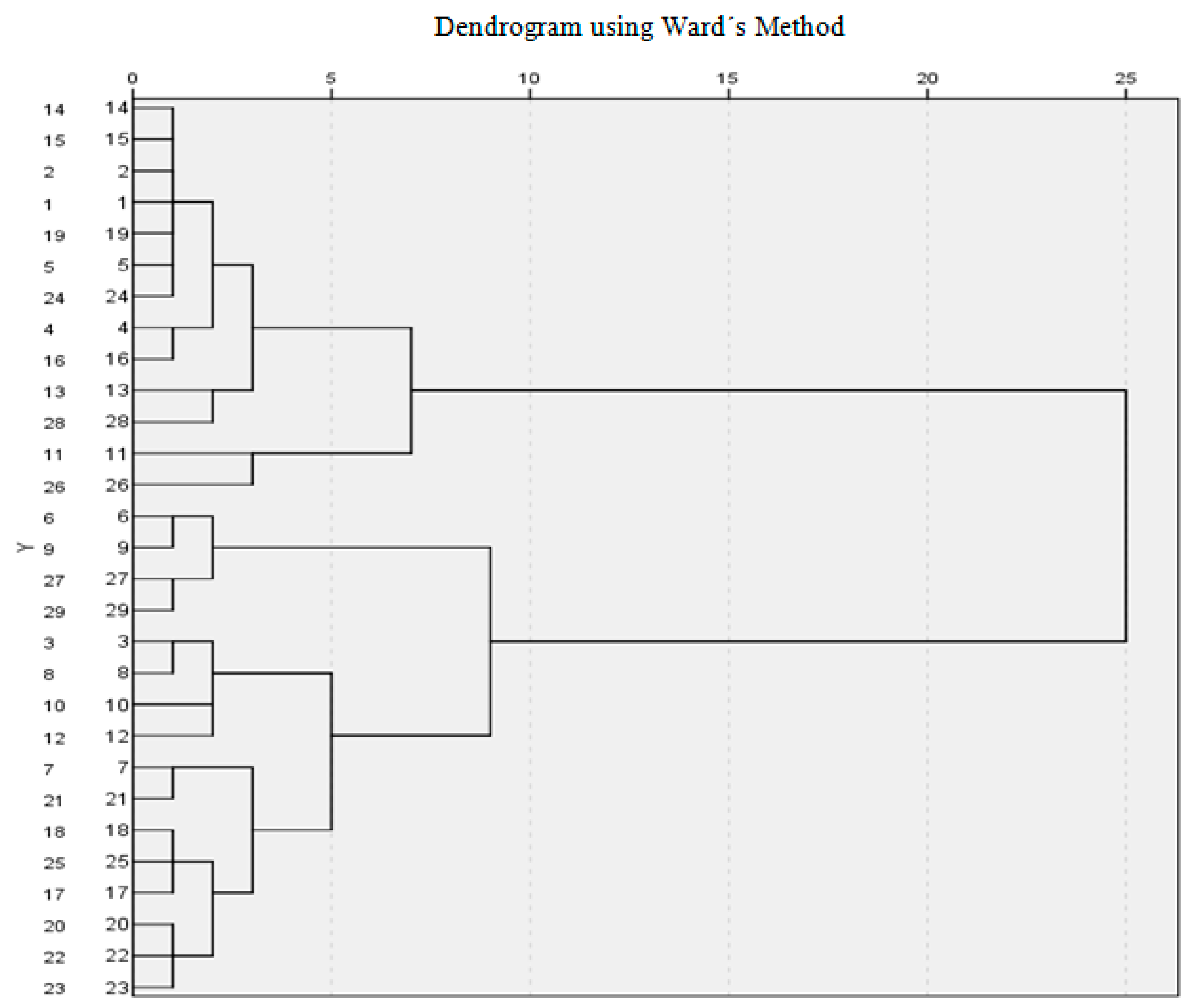
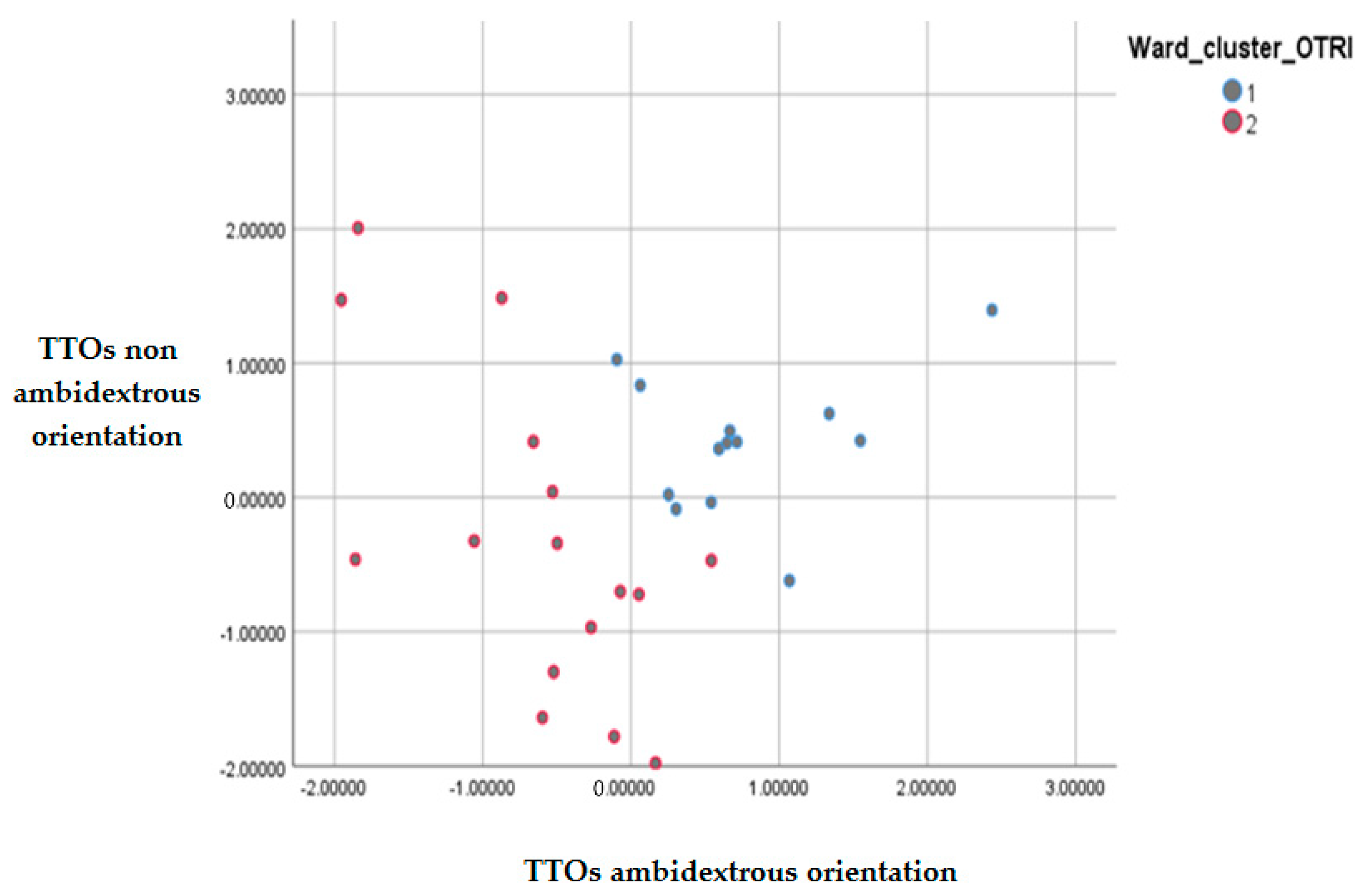
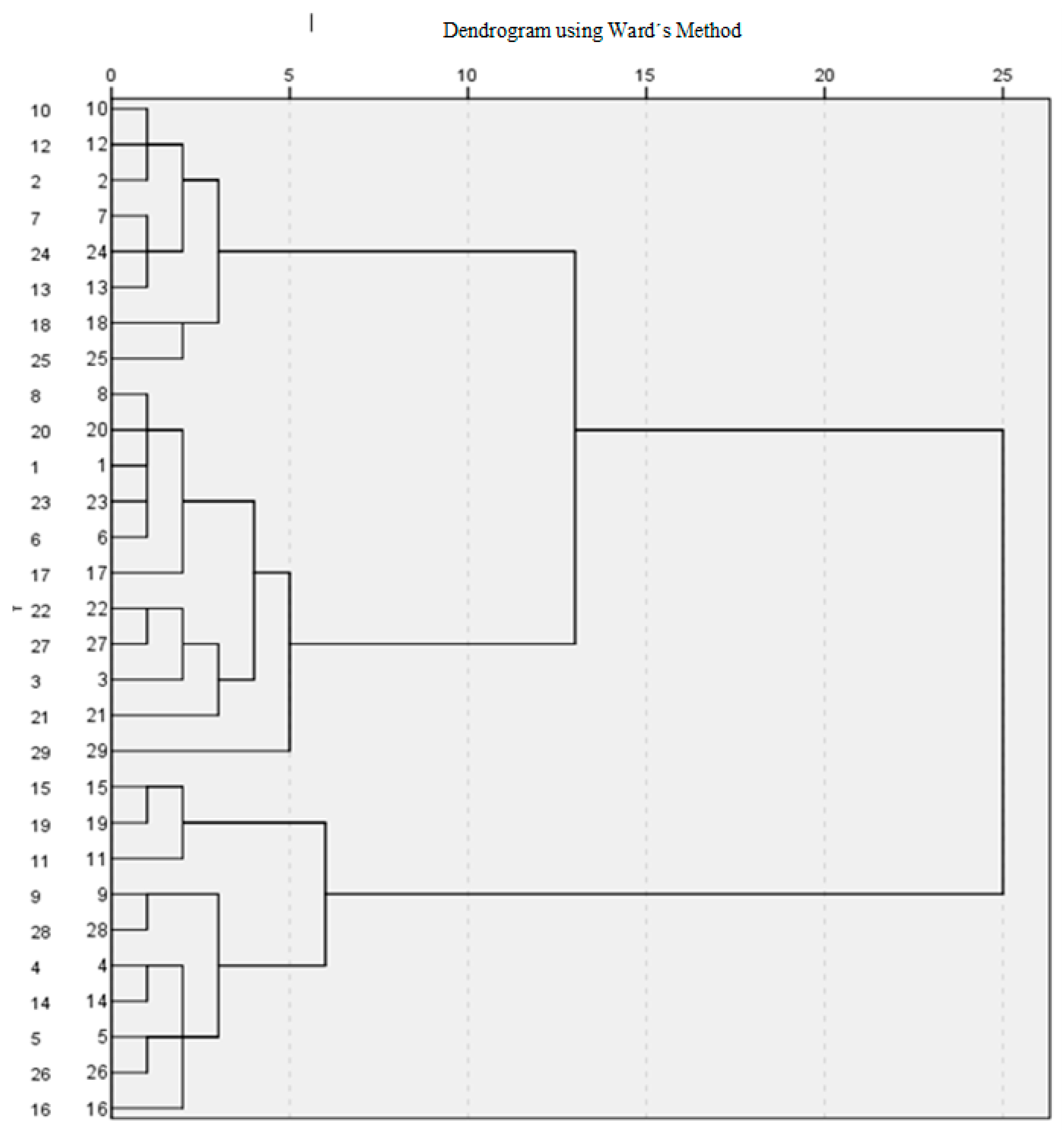
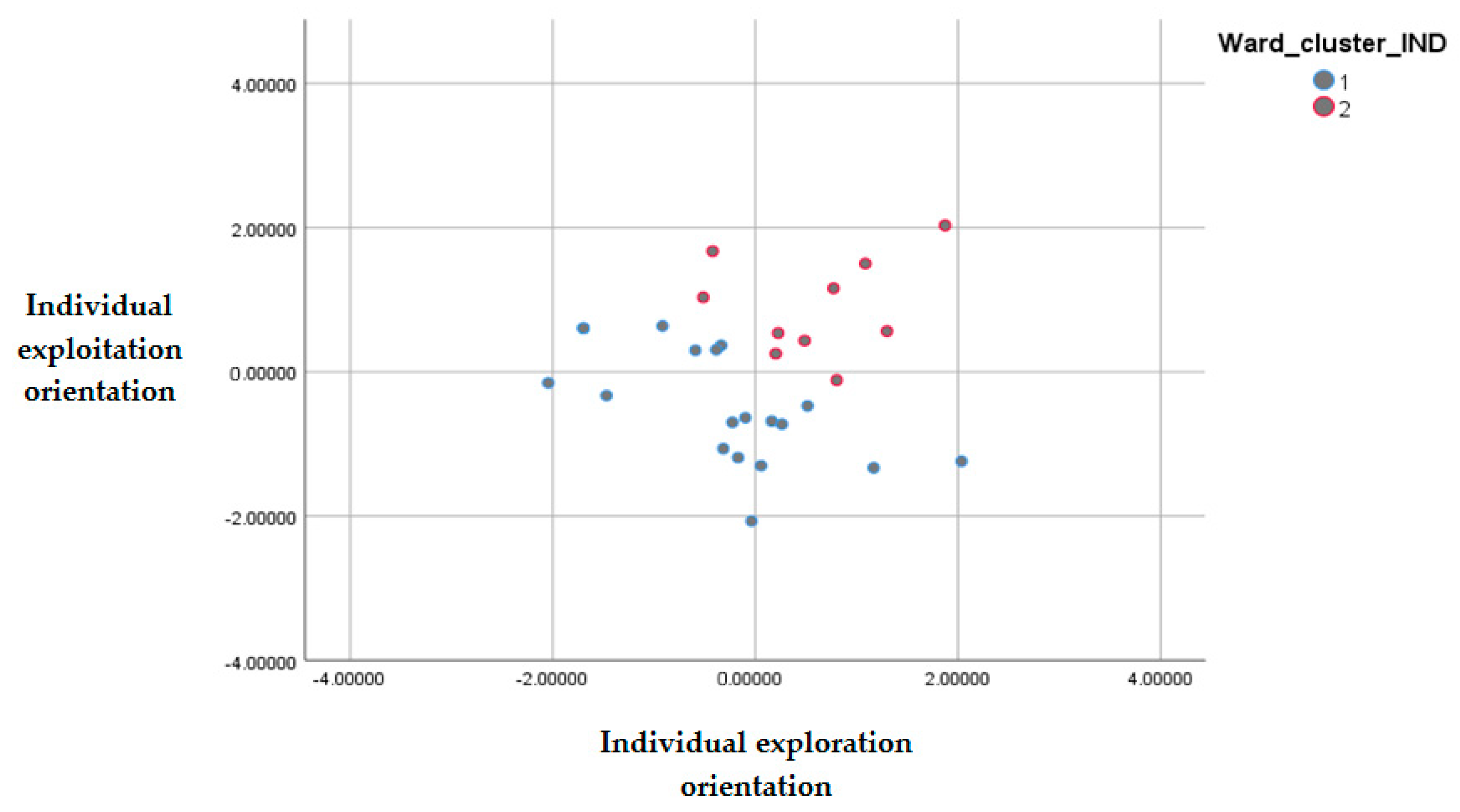
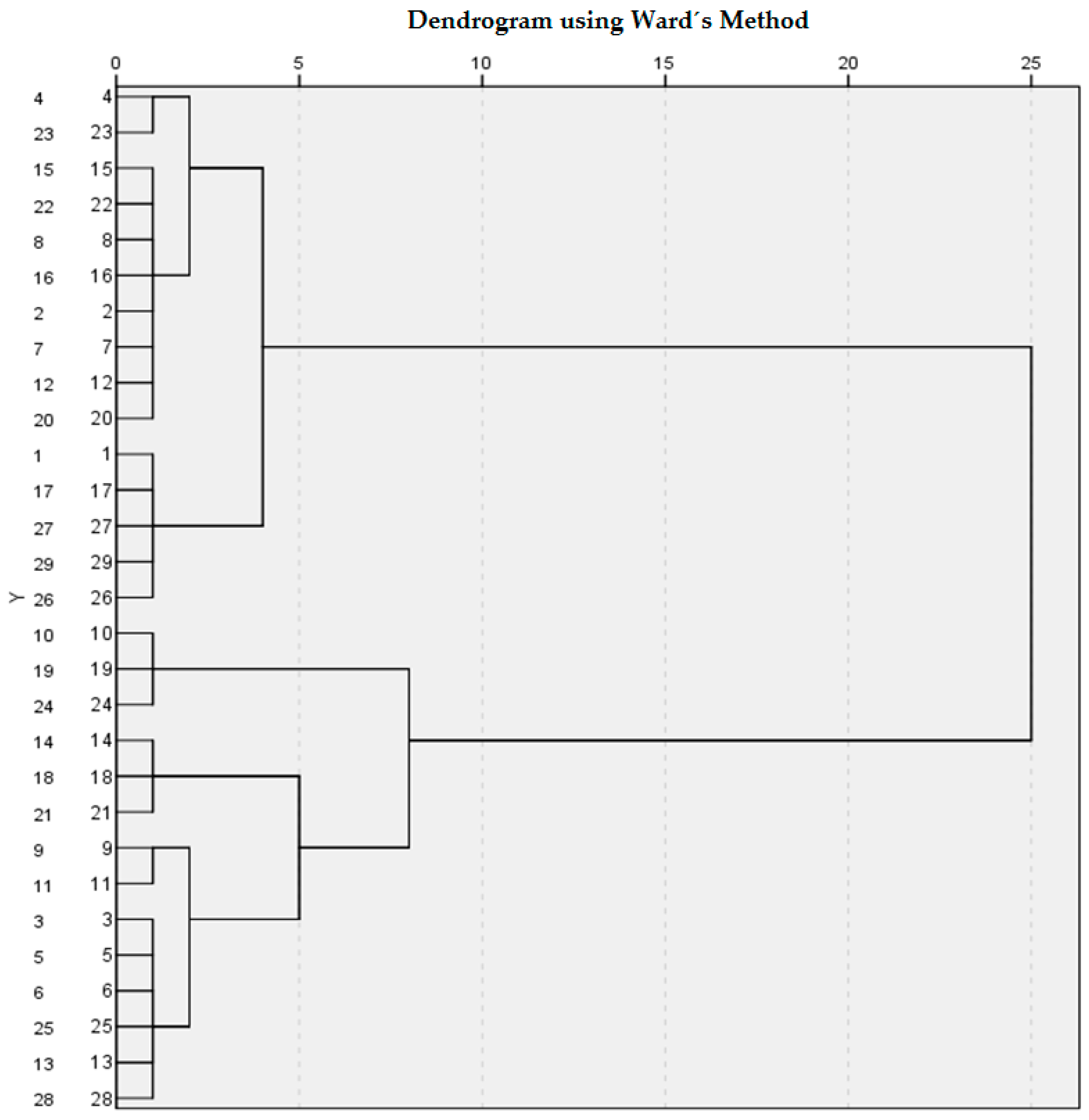
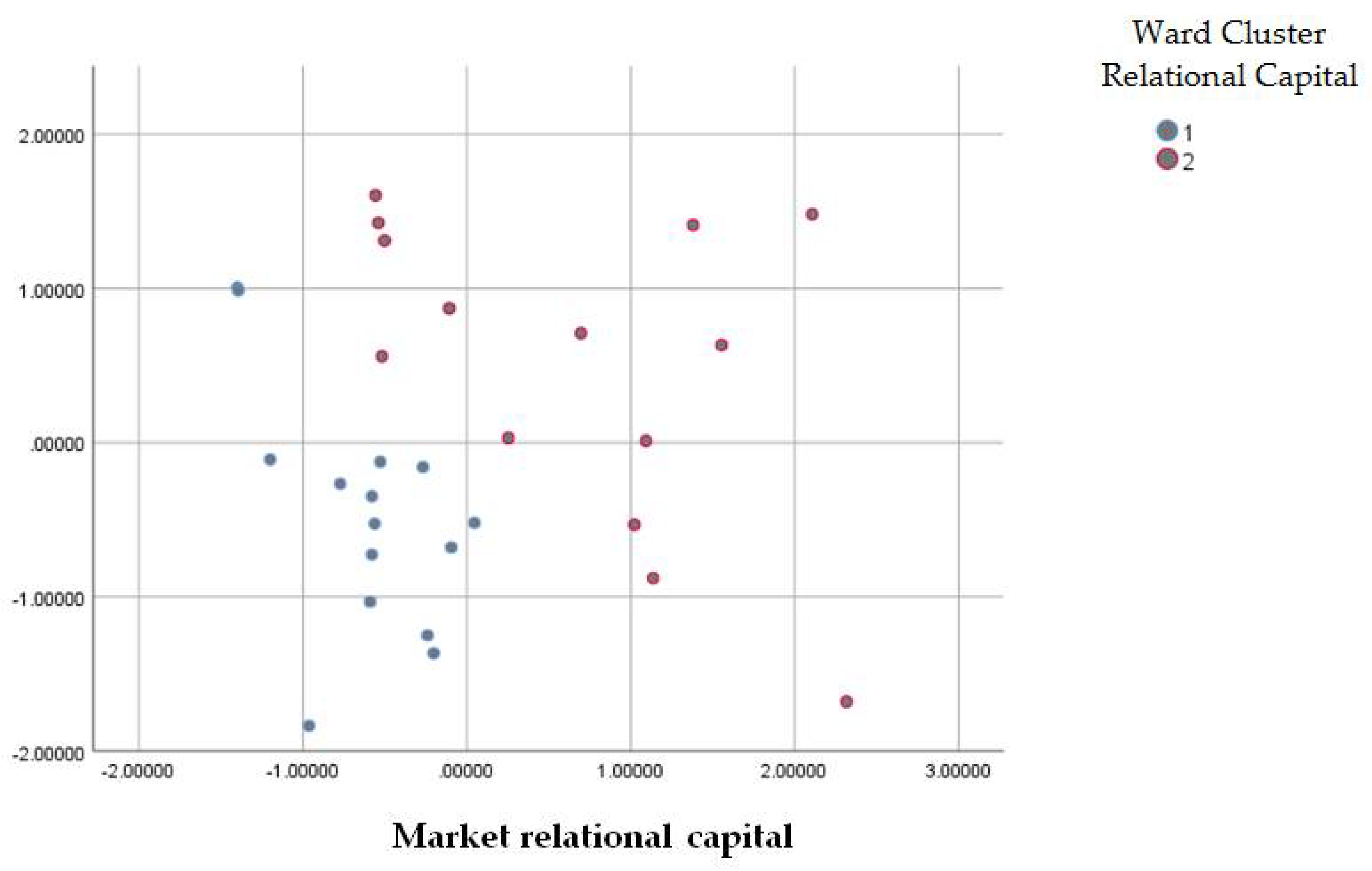
| Exploratory Guidance TTOs | Operational Guidance TTOs | Individual Explorer Guidance | Individual Exploitative Orientation | No. of Academic Staff | Frequency of Academic Actors | No. of Market Actors | Frequency of Market Actors | |
|---|---|---|---|---|---|---|---|---|
| rwg | 0.9034 | 0.9123 | 0.8991 | 0.9507 | 0.8743 | 0.8858 | 0.9000 | 0.9396 |
| Cluster 1: Ambidextrous Orientation of TTOs | Cluster 2: Non-Ambidextrous Orientation of TTOs |
|---|---|
| University of La Laguna | European University of Madrid |
| University of the Balearic Islands | University of Almeria |
| Carlos III University of Madrid | University of Vigo |
| University of Alicante | University of Santiago de Compostela |
| University of the Basque Country | University of La Coruña |
| Polytechnic University of Valencia | San Antonio Catholic University of Murcia |
| University of Zaragoza | International University of Catalonia |
| University of Cadiz | Pablo de Olavide University |
| Rovira i Virgili University | University of Las Palmas de Gran Canaria |
| University of Cordoba | University of Oviedo |
| Complutense University of Madrid | University of León |
| University of Jaén | Autonomous University of Barcelona |
| Autonomous University of Madrid | National University of Distance Education (UNED) |
| Antonio de Nebrija University | |
| University of Huelva | |
| Miguel Hernández University |
| Cluster 1: TTOs with Individuals with No Ambidextrous Orientation | Cluster 2: TTOs with Ambidextrously Oriented Individuals |
|---|---|
| University of La Laguna | Carlos III University of Madrid |
| University of the Balearic Islands | University of Alicante |
| European University of Madrid | University of La Coruña |
| University of Almeria | University of the Basque Country |
| University of Vigo | University of Zaragoza |
| University of Santiago de Compostela | University of Cadiz |
| San Antonio Catholic University of Murcia | Rovira i Virgili University |
| International University of Catalonia | University of Cordoba |
| Polytechnic University of Valencia | University of Jaén |
| Pablo de Olavide University | Autonomous University of Madrid |
| University of Las Palmas de Gran Canaria | |
| University of Oviedo | |
| University of León | |
| Autonomous University of Barcelona | |
| National University of Distance Education (UNED) | |
| Complutense University of Madrid | |
| Antonio de Nebrija University | |
| University of Huelva | |
| Miguel Hernández University |
| Cluster 1: Low Relational Capital | Cluster 2: High Relational Capital |
|---|---|
| University of La Laguna | European University of Madrid |
| University of the Balearic Islands | University of Alicante |
| Carlos III University of Madrid | University of Almeria |
| University of Vigo | University of La Coruña |
| University of Santiago de Compostela | San Antonio Catholic University of Murcia |
| International University of Catalonia | University of the Basque Country |
| University of Cadiz | Polytechnic University of Valencia |
| Rovira i Virgili University | University of Zaragoza |
| Pablo de Olavide University | University of Las Palmas de Gran Canaria |
| University of Oviedo | University of Cordoba |
| Autonomous University of Barcelona | University of León |
| National University of Distance Education | Complutense University of Madrid |
| University of Jaén | Antonio de Nebrija University |
| University of Huelva | Autonomous University of Madrid |
| Miguel Hernández University |
Publisher’s Note: MDPI stays neutral with regard to jurisdictional claims in published maps and institutional affiliations. |
© 2021 by the authors. Licensee MDPI, Basel, Switzerland. This article is an open access article distributed under the terms and conditions of the Creative Commons Attribution (CC BY) license (https://creativecommons.org/licenses/by/4.0/).
Share and Cite
Rodríguez-González, T.; Villanueva-Flores, M.; Fernández-Alles, M.; Díaz-Fernández, M. Are Spanish TTOs Prepared to Innovation in a COVID Context? Sustainability 2021, 13, 8688. https://doi.org/10.3390/su13168688
Rodríguez-González T, Villanueva-Flores M, Fernández-Alles M, Díaz-Fernández M. Are Spanish TTOs Prepared to Innovation in a COVID Context? Sustainability. 2021; 13(16):8688. https://doi.org/10.3390/su13168688
Chicago/Turabian StyleRodríguez-González, Tamara, Mercedes Villanueva-Flores, Mariluz Fernández-Alles, and Mirta Díaz-Fernández. 2021. "Are Spanish TTOs Prepared to Innovation in a COVID Context?" Sustainability 13, no. 16: 8688. https://doi.org/10.3390/su13168688
APA StyleRodríguez-González, T., Villanueva-Flores, M., Fernández-Alles, M., & Díaz-Fernández, M. (2021). Are Spanish TTOs Prepared to Innovation in a COVID Context? Sustainability, 13(16), 8688. https://doi.org/10.3390/su13168688






